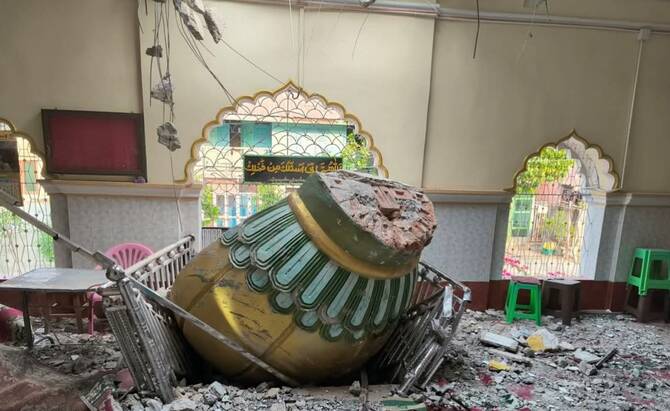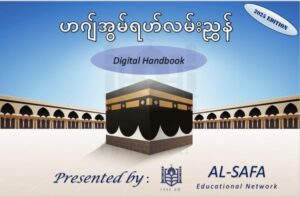MMNN Special Report: Sacred Sites Abandoned — Mosques and Churches Struggle to Rebuild After Myanmar Earthquake
By Myanmar Muslims News Network (MMNN)
I. Religious Reconstruction in Crisis: Dozens of Mosques and Churches Left in Ruins
In the aftermath of the devastating March 28 earthquake that shook central Myanmar, religious communities across Mandalay, Sagaing, and Naypyidaw are still waiting for rebuilding permits. Over 150 mosques and 50 churches suffered damage — yet only one district, Yamethin, has been granted permission to rebuild a mosque at its original scale.

According to the Ministry of Religious Affairs and Culture:
- Over 5,000 Buddhist stupas
- 3,400 monasteries
- 136 mosques
- 50 churches
- 26 Hindu temples
- 1 Chinese temple
were affected by the earthquake. While Buddhist structures have seen restoration efforts, most Muslim and Christian places of worship remain untouched.
In Mandalay alone, 64 mosques — including the historic Amyauk Tan, Shwe Bon Shein, and Panthay Mosque — were damaged. In Pyawbwe (Yamethin), 12 mosques including the ancient Aye Kariq Mosque sustained severe damage. Historic mosques in Pyinmana, Sagaing, and surrounding areas also remain unrepaired.

The Islamic Religious Council of Mandalay Region confirmed that although formal requests for demolition and reconstruction were submitted at multiple levels, no approvals have been granted. Approximately if severely damaged 25 mosques remain unrepaired, and their structural integrity continues to worsen.
II. Bureaucracy Blocks Recovery: Trustees Cite Permit Delays and Outdated Regulations
A mosque trustee from Mandalay told MMNN:

“Out of 200 mosques in Mandalay, more than 20 need major reconstruction. We’ve completed most of the prep work — but many permits for demolition or new construction are still pending.”
Mosque councils plan to submit new proposals to the Union government and appeal for approval to expand mosques in accordance with increased worshipper numbers.

However, current policy dictates that all religious buildings of Muslim and Christian must be rebuilt exactly as they were before.
“Even if the old mosque was only 40 feet wide and we now need 50, expansion is not allowed,” said the trustee.
This restriction applies to height as well:
“A one-story mosque cannot be rebuilt with two stories. No additional space is permitted.”
The trustee added that no new mosque construction is allowed on different land, nor is land allocation being offered by authorities.
III. Christian Churches Face Parallel Challenges and Heritage Restrictions
Churches across Sagaing, Mandalay, Meiktila, Taunggyi, Kalaw, Phae Khon, Dimawhso, Naypyidaw, and Bago have also been severely impacted. A Catholic priest from Mandalay shared:

“Churches over 100 years old are now considered heritage sites — and we’re not allowed to renovate them at all.”
He explained that securing approval from village administrators often requires large unofficial payments, and religious land titles are frequently rejected:
“We’ve applied for Wataka (religious) land before — but were denied. Now everything is more difficult.”
Even as historic churches deteriorate, the military administration has not stepped in to repair or preserve any of these structures. Only churches with original documentation are considered for repair — and even then, expansion or redesign is prohibited.
IV. Official Claims Contrast Ground Reality
He further added that the earthquake caused damage to many notable churches, including:
- St. Joseph’s Church (Father Laphone)
- St. Michael’s Church
- Chanthar Gone Church
- St. Mary’s Church in Mandalay
- Lourdes Church and Zawgyi Church in Yamethin
- Churches in Meiktila, Mogok, Taunggyi, Kalaw, Pekhon, and Dimawhso
- Churches in Pekhon Township (Kayah State), Bago Region, and Naypyidaw
These churches remain in various states of disrepair, with no significant restoration initiatives led by the authorities.
Despite official statements to the contrary, little aid has reached affected religious communities. In the April 11 edition of a military-run newspaper, Mandalay Region Chief Minister U Myo Aung claimed:
“All damaged religious buildings — Buddhist, Christian, Muslim, Hindu — are being inspected and supported in a timely manner.”
Yet mosque trustees and church leaders say otherwise — citing permit delays, lack of funding, and restrictive policies that prevent meaningful reconstruction.
V. Religious Demographics: The Politics Behind the Numbers
Myanmar’s official 2014 census recorded a population of 50,279,900. The religious breakdown reported:
- Buddhists: 89.8%
- Christians: 6.3%
- Muslims: 2.3%
- Hindus: 0.5%
- Animists: 0.8%
- Other religions: 0.2%
- No religion: 0.1%
Rights groups have long argued that the actual Muslim and Christian populations are underreported, contributing to underrepresentation and neglect in national policy.
Myanmar Muslims News Network (MMNN) calls on local authorities and the State Administration Council to grant unbiased, immediate reconstruction rights to all affected religious groups. The earthquake’s devastation should not be compounded by discriminatory rebuilding policies.
Credit: Irrawaddy Burmese





